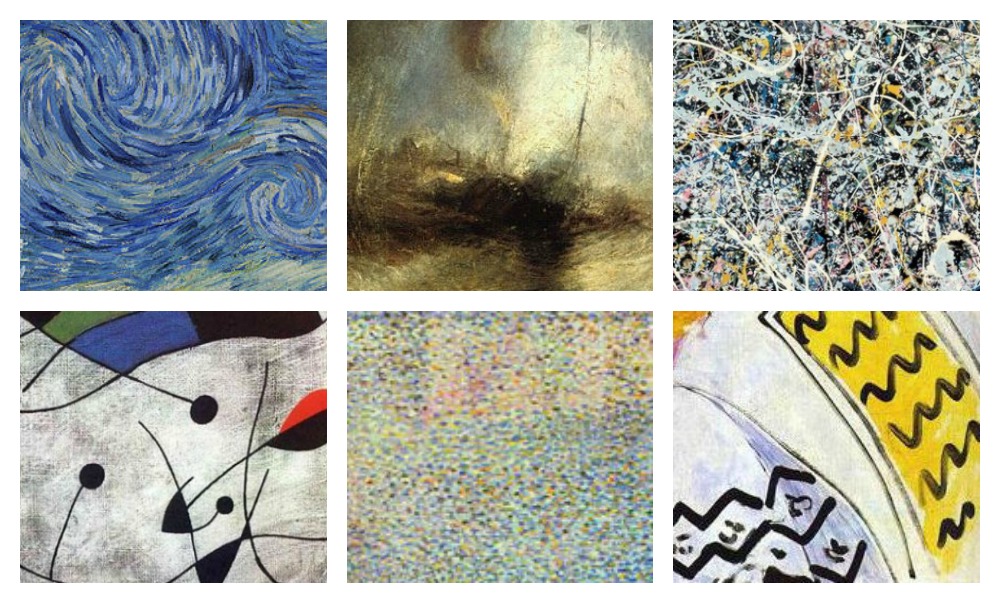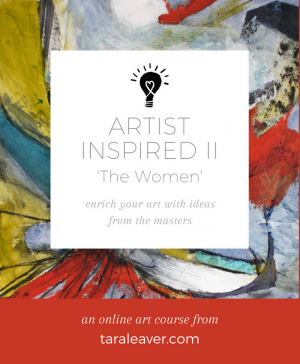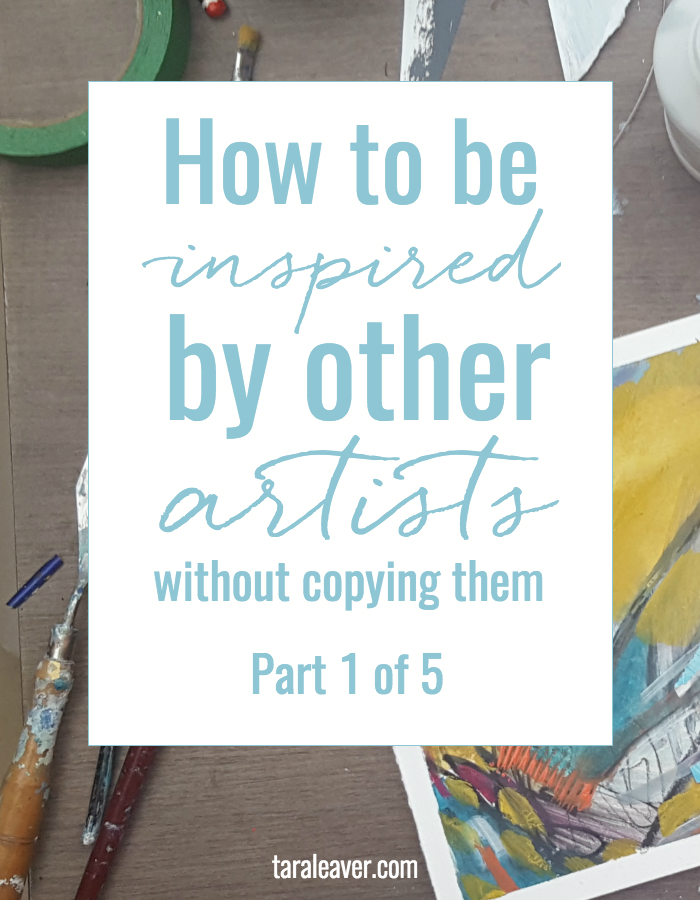Something a bit different this week! This post is the first in a series of five, focused on helping you become ever clearer about what’s unique to you, even while being inspired by other artists. {Which might be handy as we’re all being inspired all the time!}
In each ‘episode’ we’ll look at a single aspect of painting and how to tease out the nugget of what’s inspiring us so we can be sure we’re making our own work and not a heavily influenced hybrid or attempted copy of someone else’s. I’m keeping them quite short and sweet, {after today anyway!}, and action oriented, so you can take the ideas and try them out for yourself right away.
As always, I recommend an experimental and open mindset, and a willingness to not do what doesn’t sing to, to adapt it in a way that does, or to go off on another tangent altogether!
Have any of the following ever happened to you?
- You find an artist whose work you love so much you practically go into convulsions and wish you could make art like that, or wish you’d thought of that way of doing things, and then gradually {or not} your work starts to take on a suspiciously similar appearance.
- Or you start following an artist on Instagram or reading their blog, and the more their art inhabits your mental space the more your own work starts to take on attributes of theirs.
- Or you take an art class with a teacher whose work you love and your art comes out looking like theirs; maybe you still love what you’ve made, but you know it’s not completely yours, and you don’t really know how to go beyond it.
Most of us have some experience with at least one of these situations. I definitely have! And in my day-to-day romps around the internet I see a lot of people who I don’t think actually realise they’re doing it.
It can be a sly little bugger, influence.
So how do you take the inspiration without also taking on the style and look of the work you love so much?
It can be a tricky balance, especially since most of us want to be always developing our skills and abilities, as artists we are basically sensitive sponges, and we constantly have our art antennae up.
If this sounds familiar, there are ways to be inspired without resorting to copying.
And let’s not forget, there’s nothing wrong with copying as a means to learning; it’s when we don’t move beyond that that we’re not being true to ourselves, or fair to those who inspire us.
Even when we don’t believe we could make something ‘as good’, or doubt our own ability to make unique-to-us art, there is always more room to develop and transform.
I have no doubt there are infinite ways to do this, and in part it will just happen the more you paint, but the ways I find most helpful include a bit of left brain analysis and a breaking down into parts.
The right brain can then rebuild into new things with the new ideas – and a large amount of this will be happening subconsciously, so no need to try and force anything!
So here is the first of five ways we’ll look at to take inspiration from artists whose work you love while still putting your individual stamp on your own.
Look at how they make marks
One very obvious and distinctive way that an artist’s work becomes recognisable as theirs is by the marks they use.
This is in large part instinctive and natural, and evolves into something cohesive and more fully developed over time; you actually can’t fail to develop your own marks if you keep going!
It’s like handwriting; no one has the exact same handwriting as you, with its tiny nuances and curly bits, and when you were learning how to write, it evolved as you grew more comfortable doing it.
Now you don’t think about it, you just write.
Same with painting {mostly}.
Below are some sections of works by famous artists who have distinctive marks. Can you guess whose paintings they are just from the marks? I’m guessing you probably can, which illustrates my point nicely. 🙂
{And don’t forget they were at it for years, every day!}
*Answers at the bottom of the post!

Of course you can’t ever really isolate marks from colour palette, composition and all the other aspects of painting, as well as that ineffable essence we each have that combine to make a painting recognisable.
However, I find that breaking it down a bit and looking a little more closely, and then doing some pondering and experimenting, goes a long way to learning ourselves and our ways as artists more deeply and with greater clarity and confidence.
A suggestion to make it yours:
Love a certain type of line or mark? Try using it in as many ways as you can come up with:
- make it with your non-dominant hand
- make it with a stick instead of a brush
- use a huge brush and then a tiny one
- make it with charcoal, pencil, ink, pastel {oil and/or soft}, and paint
- make one huge version of it or hundreds of tiny ones in a pattern or block
- make it with collage
- challenge yourself to come up with three further ways to make the mark
Related post: 36 ways to draw a tree
Try this
One easy way to do this, if you like a bit of guidance and structure, is to divide a piece of paper into segments, as many as you like. In each segment, aim to make a different mark.
Challenge yourself to go beyond the obvious and easy, {and by all means get them out of the way right off the bat}, and prepare to be joyfully surprised by what you discover!
If you need less structure, do the whole lot on a single large sheet of paper and really go to town layering and mixing them up!
Some marks will feel boring, some will spark a little something but not feel quite ‘it’, some will feel zingy, some just ok.
Stay alert to how your body and feelings respond to each thing you try – this is the single most useful way to discover what’s really yours, in my experience.
Your body knows, so let it tell you. It will also give you an opportunity to develop a clearer channel to your intuition, which is useful for all areas of life! Wins all round.
 I hope this little series has given you some ideas and things to try as you explore what paint can do. If you’d like to play further with other artists’ work in a way that can teach you about your own, then you might like Artist Inspired II.
I hope this little series has given you some ideas and things to try as you explore what paint can do. If you’d like to play further with other artists’ work in a way that can teach you about your own, then you might like Artist Inspired II.
Packed with visuals, videos, ideas to explore, and a look at the life and work of each artist, the course invites you to enjoy being inspired by various female artists as a means to finding your own unique voice as an artist.
The course is available inside the Happy Artist Studio, so you actually get the full library of courses, a built in community for support, and a host of other goodies to help you on your artist path!
Click here to find out more!
In Part Two, we’ll be looking at colour palettes. Stay tuned!
*Artists left to right: Van Gogh, Turner, Pollock, Miro, Seurat, Matisse








So refreshing to hear this advice Tara, thank you.
So glad you feel that Louise!
Thank you so much, Tara. I have so much to learn, but I always want to do my own art..the way I like it. You inspire me.
Thank you Connie! So glad to hear that and yes – the way you like it. 🙂
Thanks for such a good aspect of art.. Looking forward for more .
Thank you once again for inspiring .
Glad you’ve taken something helpful from it!
I do struggle with making my on style…..not even sure what it is yet…..will try your mark suggestion.
It’s a very common stumbling block, and really only resolved by making a lot of art! But good to have some tools and things to try to help it along. 🙂
Very interesting read. Thank you for sharing this, I’ve been struggling with this problem mostly because I am a sculptor and I find it hard to make time for painting but when I do, I have to paint from someone’s painting and I hate it so much. Thanks again. I’m definitely moving to part 2
So glad it was helpful in some way Helen!
Just got to your article today and “this” is what’s been on my mind.
Making it my own! Thanks for the suggestionsQ
You’re welcome! Glad it struck a chord.
Thank you for an excellent article. Trying lots of different styles and subjects you will naturally develop your own style.
Billy
Many thanks Tara, my brain has gone into overdrive already!
Excellent!
I find myself very interested! I’m trying to get back into my painting after a long break (due to health), changing from painting on antique windows to canvasses. Its like learning all over again! Slow going right now, trying to figuring out my niche!
It took me a long time, and even now it shifts and changes within itself all the time. I think often we do have to unlearn a lot to make our own discoveries.
I love your outlook on art and the creative process involved. Thanks for the inspiration to produce individual art.
Thank you! Always happy to be useful. 🙂
75 yrs young, 10 yrs currently of almost non stop working in all mediums, mostly oils, pencil on war color paper. Can’t find my own style, can’t break the habit of not using someone else’s work, like I can’t do it unless I look at it. Art teacher says I’m unteachable,but I’m so willing. Thank you
No one is unteachable unless they don’t want to learn, in my humble opinion! 😉 It can take a while to loosen the grip of the old habits and ingrained ‘rules’, but it’s totally possible!
Thank u Tara I’m getting pretty good at painting but i mostly copy.. so i would love to find my own voice. I’m very interested in your information on achieving that. Love your site.
You’ll get there! Just keep going. 🙂
So happy that dad bs you! I’m new to Painting again after a 40;year absence? More of a street photographer! Look forward to more!
Thank you